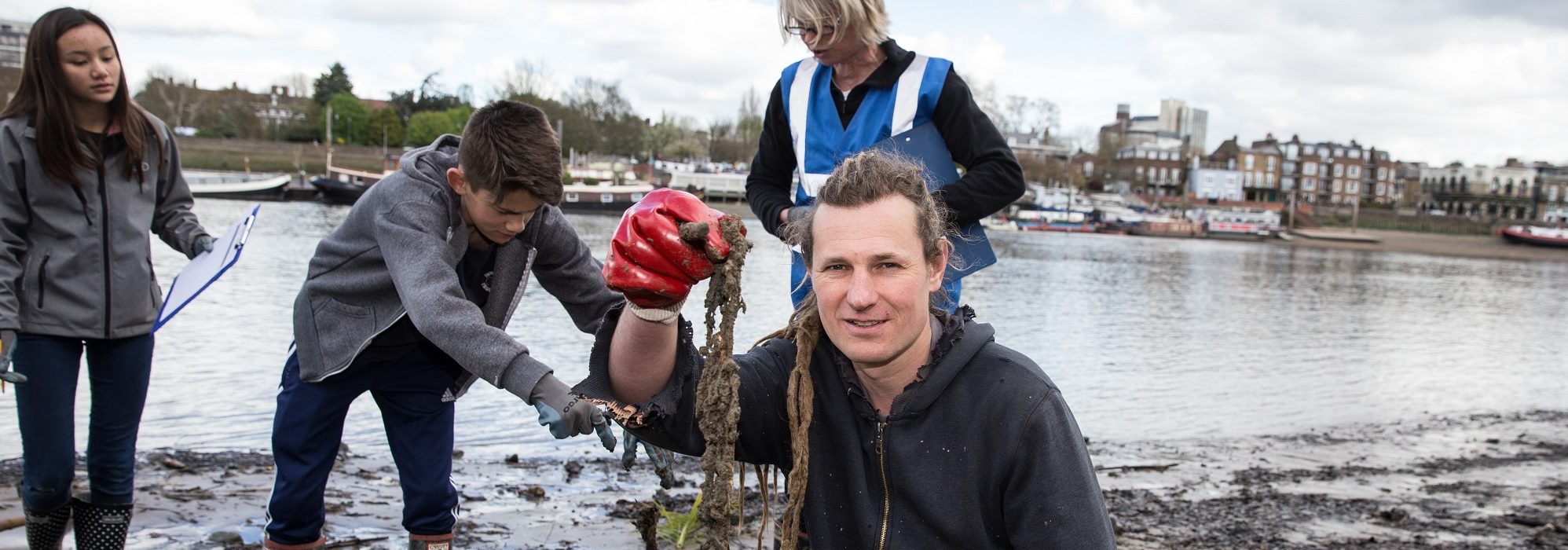Londoners rally to measure plastic’s hidden impact on the Thames
Thousands of wet wipes flushed down toilets are shedding plastic into the river and changing the shape of the riverbed
Date of release: Monday 16 April 2018
In light of the recent surge in public interest in plastic in our rivers and oceans, Londoners are invited to join the river’s key annual citizen science event, The Big Count on Saturday April 21.
Organised by Thames21 the event will measure the impact of wet wipes (which contain plastic) on the most iconic river in the world.
Reporters and photographers are invited to join us on the south side of Hammersmith Bridge between 12.30pm – 3.30pm for the event that starts at 12.45pm.
See map attached or: www.thames21.org.uk/event/thames-river-watch-big-count/
The aim is to quantify the impact of wet wipes on the capital’s river, and to see if the problem has got better or worse since last year when 4500 wet wipes were recorded in just a few hours, at an average of 40 per square metre.
The event will be attended by Leonie Cooper, chair of the Greater London Authority’s Environment Committee.
Thames21’s Thames River Watch is the only programme monitoring water quality and the impact of plastic on the Thames. It empowers people to connect with and protect the Thames by collecting key data that builds a greater understanding of the river’s health.
“Most people don’t realise that wet wipes contain plastic – partly due to incorrect labelling,” said Alice Hall, Thames River Watch Programme Coordinator. “They never break down completely and flushing them adds to the global microplastics problem affecting our rivers and oceans. Yet thousands of them regularly make their way into the Thames when rainfall causes the sewage system to overflow.
“Wet wipes are now so common in the Thames that new ‘sandbanks’ made from wet wipes wrongly flushed down the toilet, have formed in places where the river bends and the flow of water is slower. These wet wipes are likely to be shedding their plastic, which is a threat to wildlife in our rivers and oceans.”
The problem is a hidden menace, because these wet wipes are easily disguised on the bottom of the Thames riverbed.
“At low tide we get a chance to shine a light on the problem. We’re delighted Londoners have rallied round to help us survey as much of the shore as we can before the tide turns!” explained Alice Hall.
The Big Count will coincide with a low tide when the river is low enough to reveal parts of the riverbank which are normally hidden.
Thames21’s The Big Count, now in its fourth year, is an opportunity for the public to contribute to the ongoing Thames River Watch citizen science programme monitoring the health of the Thames.
Data collected gives a snapshot of the Thames’ health year on year. Previous reports have highlighted wet wipes as one of the top ten plastic items blighting the Thames, but the problem is under-reported due to the difficulty in accessing sites where they deposit.
The Thames River Watch project is funded by Tideway, the company building the Thames Tideway Tunnel.
Andrew Triggs Hodge, Tideway’s Reconnection Legacy Project Manager, said: “It’s a blight on our great capital city that tens of millions of tonnes of untreated sewage, including wet wipes, and other plastic, has ended up in the River Thames each year causing harm to wildlife.
“The Thames Tideway Tunnel, currently under construction, will help tackle this problem when complete in 2024. However the blight of plastic littering our capital’s foreshore remains. It is vital that we help support initiatives like the Thames River Watch programme to help raise awareness, and support the legions of volunteers who roll up their sleeves and help remove the generations of plastic waste from the foreshore.”
ENDS
Notes for editors
Media Contacts
Kirsten Downer
Thames21 Communications Officer
Kirsten.Downer@thames21.org.uk
07711 701 696
020 7248 7171
Ian Lamont
Communications Manager
Ian.Lamont@thames21.org.uk
07739 627 667
020 7248 7171
About Thames21
Thames21 is an environmental charity putting healthy rivers back at the heart of community life. Through environmental improvements, education, research and advocacy efforts, Thames21 is inspiring and influencing effective and lasting change by working hand-in-hand with communities to deliver tangible and measurable improvements for urban rivers.
www.thames21.org.uk | Registered Charity No. 1103997
About Thames River Watch
Thames River Watch was set up by Thames21 and is the only citizen science programme measuring the water quality of the Thames and the impact of plastic on the river. Key data is published annually: the next one is due in March.
Volunteering for Thames River Watch
A citizen science army of Londoners have been trained for free under the Thames River Watch programme to carry out plastic litter surveying, water quality tests, or act as Thames Ambassadors. Volunteers commit to two hours per month. http://www.thames21.org.uk/thames-river-watch/
Thames River Watch hub sites
Four local hub sites have been established at Hammersmith, Battersea, Greenwich and Isle of Dogs. http://www.thames21.org.uk/thames-river-watch/
EVENT DETAILS
The event takes place on Saturday April 21, between 12.30-3.30pm. Meeting point is on the Thames path, south side of Hammersmith Bridge: www.thames21.org.uk/event/thames-river-watch-big-count/
